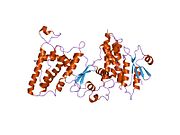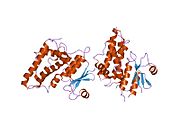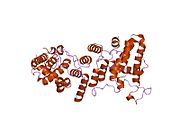CLIC1
Jump to navigation
Jump to search
Chloride intracellular channel protein 1 is a protein that in humans is encoded by the CLIC1 gene.[5][6]
Chloride channels are a diverse group of proteins that regulate fundamental cellular processes including stabilization of cell membrane potential, transepithelial transport, maintenance of intracellular pH, and regulation of cell volume. Chloride intracellular channel 1 is a member of the p64 family; the protein localizes principally to the cell nucleus and exhibits both nuclear and plasma membrane chloride ion channel activity.[6]
Interactions
CLIC1 has been shown to interact with TRAPPC2.[7]
See also
References
- ^ a b c ENSG00000223639, ENSG00000226248, ENSG00000226651, ENSG00000226417, ENSG00000230685, ENSG00000206394 GRCh38: Ensembl release 89: ENSG00000213719, ENSG00000223639, ENSG00000226248, ENSG00000226651, ENSG00000226417, ENSG00000230685, ENSG00000206394 – Ensembl, May 2017
- ^ a b c GRCm38: Ensembl release 89: ENSMUSG00000007041 – Ensembl, May 2017
- ^ "Human PubMed Reference:". National Center for Biotechnology Information, U.S. National Library of Medicine.
- ^ "Mouse PubMed Reference:". National Center for Biotechnology Information, U.S. National Library of Medicine.
- ^ Valenzuela SM, Martin DK, Por SB, Robbins JM, Warton K, Bootcov MR, Schofield PR, Campbell TJ, Breit SN (Jun 1997). "Molecular cloning and expression of a chloride ion channel of cell nuclei". J Biol Chem. 272 (19): 12575–82. doi:10.1074/jbc.272.19.12575. PMID 9139710.
- ^ a b "Entrez Gene: CLIC1 chloride intracellular channel 1".
- ^ Fan L, Yu Wei, Zhu Xueliang (Apr 2003). "Interaction of Sedlin with chloride intracellular channel proteins". FEBS Lett. 540 (1–3). Netherlands: 77–80. Bibcode:2003FEBSL.540...77F. doi:10.1016/S0014-5793(03)00228-X. ISSN 0014-5793. PMID 12681486. S2CID 8573651.
Further reading
- Singh H (2010). "Two decades with dimorphic Chloride Intracellular Channels (CLICs)". FEBS Letters. 584 (10): 2112–21. Bibcode:2010FEBSL.584.2112S. doi:10.1016/j.febslet.2010.03.013. PMID 20226783. S2CID 21056278.
- Okubo K, Hori N, Matoba R, et al. (1994). "Large scale cDNA sequencing for analysis of quantitative and qualitative aspects of gene expression". Nat. Genet. 2 (3): 173–9. doi:10.1038/ng1192-173. PMID 1345164. S2CID 35309579.
- Frigerio JM, Berthézène P, Garrido P, et al. (1995). "Analysis of 2166 clones from a human colorectal cancer cDNA library by partial sequencing". Hum. Mol. Genet. 4 (1): 37–43. doi:10.1093/hmg/4.1.37. PMID 7711732.
- Singh H, Ashley RH (2006). "Redox Regulation of CLIC1 by Cysteine Residues Associated with the Putative Channel Pore". Biophys. J. 90 (5): 1628–1638. Bibcode:2006BpJ....90.1628S. doi:10.1529/biophysj.105.072678. PMC 1367314. PMID 16339885.
- Liew CC, Hwang DM, Fung YW, et al. (1994). "A catalogue of genes in the cardiovascular system as identified by expressed sequence tags". Proc. Natl. Acad. Sci. U.S.A. 91 (22): 10645–9. Bibcode:1994PNAS...9110645L. doi:10.1073/pnas.91.22.10645. PMC 45078. PMID 7938007.
- Maruyama K, Sugano S (1994). "Oligo-capping: a simple method to replace the cap structure of eukaryotic mRNAs with oligoribonucleotides". Gene. 138 (1–2): 171–4. doi:10.1016/0378-1119(94)90802-8. PMID 8125298.
- Heiss NS, Poustka A (1997). "Genomic structure of a novel chloride channel gene, CLIC2, in Xq28". Genomics. 45 (1): 224–8. doi:10.1006/geno.1997.4922. PMID 9339381.
- Suzuki Y, Yoshitomo-Nakagawa K, Maruyama K, et al. (1997). "Construction and characterization of a full length-enriched and a 5'-end-enriched cDNA library". Gene. 200 (1–2): 149–56. doi:10.1016/S0378-1119(97)00411-3. PMID 9373149.
- Tulk BM, Edwards JC (1998). "NCC27, a homolog of intracellular Cl− channel p64, is expressed in brush border of renal proximal tubule". Am. J. Physiol. 274 (6 Pt 2): F1140–9. doi:10.1152/ajprenal.1998.274.6.F1140. PMID 9841507. S2CID 39652235.
- Chuang JZ, Milner TA, Zhu M, Sung CH (1999). "A 29 kDa intracellular chloride channel p64H1 is associated with large dense-core vesicles in rat hippocampal neurons". J. Neurosci. 19 (8): 2919–28. doi:10.1523/JNEUROSCI.19-08-02919.1999. PMC 6782274. PMID 10191309.
- Ribas G, Neville M, Wixon JL, et al. (1999). "Genes encoding three new members of the leukocyte antigen 6 superfamily and a novel member of Ig superfamily, together with genes encoding the regulatory nuclear chloride ion channel protein (hRNCC) and an N omega-N omega-dimethylarginine dimethylaminohydrolase homologue, are found in a 30-kb segment of the MHC class III region". J. Immunol. 163 (1): 278–87. doi:10.4049/jimmunol.163.1.278. PMID 10384126.
- Berryman M, Bretscher A (2000). "Identification of a Novel Member of the Chloride Intracellular Channel Gene Family (CLIC5) That Associates with the Actin Cytoskeleton of Placental Microvilli". Mol. Biol. Cell. 11 (5): 1509–21. doi:10.1091/mbc.11.5.1509. PMC 14863. PMID 10793131.
- Tonini R, Ferroni A, Valenzuela SM, et al. (2000). "Functional characterization of the NCC27 nuclear protein in stable transfected CHO-K1 cells". FASEB J. 14 (9): 1171–8. doi:10.1096/fasebj.14.9.1171. PMID 10834939. S2CID 30652670.
- Valenzuela SM, Mazzanti M, Tonini R, et al. (2001). "The nuclear chloride ion channel NCC27 is involved in regulation of the cell cycle". J. Physiol. 529 (3): 541–52. doi:10.1111/j.1469-7793.2000.00541.x. PMC 2270212. PMID 11195932.
- Harrop SJ, DeMaere MZ, Fairlie WD, et al. (2002). "Crystal structure of a soluble form of the intracellular chloride ion channel CLIC1 (NCC27) at 1.4-A resolution". J. Biol. Chem. 276 (48): 44993–5000. doi:10.1074/jbc.M107804200. PMID 11551966.
- Warton K, Tonini R, Fairlie WD, et al. (2002). "Recombinant CLIC1 (NCC27) assembles in lipid bilayers via a pH-dependent two-state process to form chloride ion channels with identical characteristics to those observed in Chinese hamster ovary cells expressing CLIC1". J. Biol. Chem. 277 (29): 26003–11. doi:10.1074/jbc.M203666200. PMID 11978800.
- Shanks RA, Larocca MC, Berryman M, et al. (2002). "AKAP350 at the Golgi apparatus. II. Association of AKAP350 with a novel chloride intracellular channel (CLIC) family member". J. Biol. Chem. 277 (43): 40973–80. doi:10.1074/jbc.M112277200. PMID 12163479.
- Strausberg RL, Feingold EA, Grouse LH, et al. (2003). "Generation and initial analysis of more than 15,000 full-length human and mouse cDNA sequences". Proc. Natl. Acad. Sci. U.S.A. 99 (26): 16899–903. Bibcode:2002PNAS...9916899M. doi:10.1073/pnas.242603899. PMC 139241. PMID 12477932.
- Fan L, Yu W, Zhu X (2003). "Interaction of Sedlin with chloride intracellular channel proteins". FEBS Lett. 540 (1–3): 77–80. Bibcode:2003FEBSL.540...77F. doi:10.1016/S0014-5793(03)00228-X. PMID 12681486. S2CID 8573651.
- Mungall AJ, Palmer SA, Sims SK, et al. (2003). "The DNA sequence and analysis of human chromosome 6". Nature. 425 (6960): 805–11. Bibcode:2003Natur.425..805M. doi:10.1038/nature02055. PMID 14574404.
- Littler DR, Harrop SJ, Fairlie WD, et al. (2004). "The intracellular chloride ion channel protein CLIC1 undergoes a redox-controlled structural transition". J. Biol. Chem. 279 (10): 9298–305. doi:10.1074/jbc.M308444200. PMID 14613939.
- Singh H, Cousin MA, Ashley RH (2007). "Functional reconstitution of mammalian 'chloride intracellular channels' CLIC1, CLIC4 and CLIC5 reveals differential regulation by cytoskeletal actin". FEBS J. 274 (24): 6306–6316. doi:10.1111/j.1742-4658.2007.06145.x. PMID 18028448. S2CID 22494250.
External links
- CLIC1+protein,+human at the U.S. National Library of Medicine Medical Subject Headings (MeSH)
- Human CLIC1 genome location and CLIC1 gene details page in the UCSC Genome Browser.
This article incorporates text from the United States National Library of Medicine, which is in the public domain.










